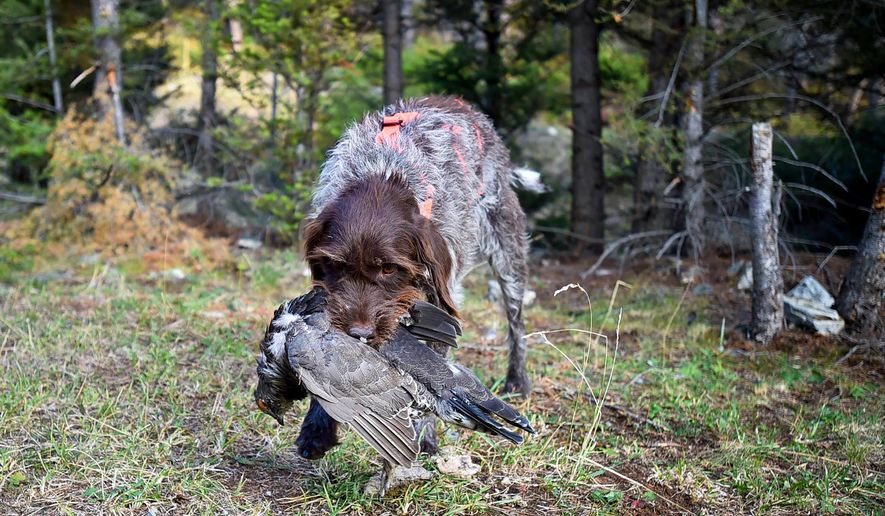HELENA, Mont. (AP) - Few things may be more heart-pounding for a hiker or hunter than a mountain grouse’s unexpected flush along a quiet trail.
Whether it’s a chance encounter while archery hunting for elk, or toting a shotgun in the company of a bird dog for long jaunts along the Continental Divide, hunting Montana’s trio of mountain grouse species often falls somewhere between opportunistic and intentional.
However hunters find them, visiting the birds’ mountainous haunts and hearing the echo of beating wings is a great way to find some fine table fare.
Montana has multiple native grouse species. The prairie and breaks country are prime areas for sharp-tailed and sage grouse. The central and western mountains are home to blue grouse, also known as dusky grouse, ruffed grouse, and spruce grouse, sometimes called Franklin’s grouse. White-tailed ptarmigan, which cannot be hunted, also occupy some alpine areas of northwestern Montana.
The huntable mountain varieties have among the longest seasons of all upland birds in the state, stretching from Sept. 1 through Jan. 1, with hunters allowed three per day in any combination and 12 in possession.
“They live in similar areas but each exploits slightly different aspects of the habitat as far as forest canopy and have some differences in their diets,” Brian Wakeling, Game Management Bureau chief for Montana Fish, Wildlife & Parks, told the Independent Record.
Blue or dusky grouse, the largest of the mountain species, are slate in color mixed with brown and white-tipped feathers. Males have yellow combs over their eyes, according to the Montana Field Guide.
The chicken-sized birds thrive in the high country. Blues typically seek out ridgelines and grassy meadows of bunchgrass for hunting grasshoppers and other insects, but also feed on a mix of plants and berries depending on the time of year.
Blues can be the wariest of the mountain species, tending to flush more quickly but still apt to alight in a close tree, believing the height provides safety from predators.
Ruffed grouse are smaller than blues with brownish bodies and black bands of feathers on their tails. While they may be found in a wide variety of habitats, the birds are more likely to be found in lower elevation creek bottoms and riparian areas, and according to the field guide, spend their lives in a small home range. There, they eat a combination of insects and plants.
Bumping a flock of ruffed grouse from a thicket can be like opening a floodgate, with birds flushing in multiple directions - some landing in trees and others flying out of sight - or some simply walking briskly away on the ground.
Spruce grouse are the darkest of the mountain varieties, with dark gray to nearly black coloration and sprinkles of white plumage. Males have dark red eye combs making them easily identifiable from the other species.
Spruce grouse, as their name implies, seek out dense conifer forests where they eat needles and other vegetation and insects.
Their lack of wariness has earned the birds the dubious nickname “fool hen,” as they often stand or walk only a short distance when spooked and fly up into a nearby tree to observe.
Montana’s mountain grouse species are both lightly hunted and common in many areas, including the state’s remotest stretches, so much of the information game managers receive about their population health comes from hunters.
“They’re difficult to get a survey,” Wakeling said. “It’s cost prohibitive and difficult, so for many species harvest data is an indication on how those populations are doing.”
In some circumstances, FWP has asked hunters to provide a wing from upland birds to study populations and trends. During a 2018 collection in southwest Montana, Butte-area biologist Vanna Boccadori said the wings provide a variety of data including sex and ratio of juvenile to adult birds.
“That gives us an indication of how the population as a whole is doing,” Boccadori said at the time, adding that biologists want to monitor trends over time rather than year to year.
Because of where they live, mountain grouse tend to see fewer disease outbreaks than birds such as waterfowl that migrate and are exposed to a variety of areas and conditions, Wakeling said. The biggest factor driving grouse populations by far is the weather.
“Sometimes I feel like a farmer talking about these things because it’s always either it didn’t rain, it rained too much, invertebrates didn’t take off, but it is a range of conditions and they affect grouse species differently,” he said.
Grouse are dependent on good green-up in the spring to help with nutrition after winter and going into nesting season when male forest grouse put on legendary drumming displays. Then, birds may wait to incubate eggs until after a full clutch is laid. If a spring cold snap comes, that could cause them to lose the nest, although some birds may re-nest, Wakeling said.




Please read our comment policy before commenting.